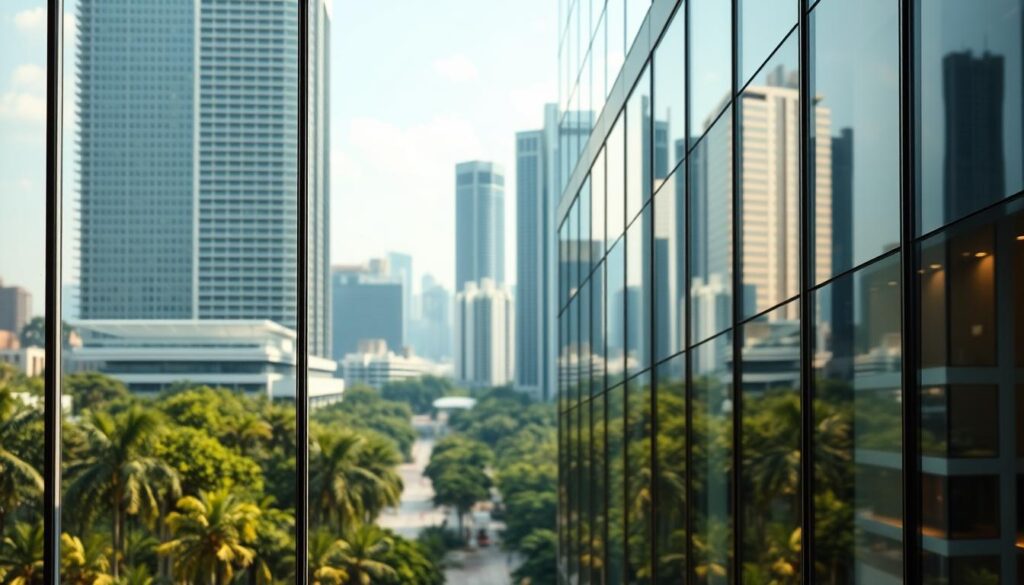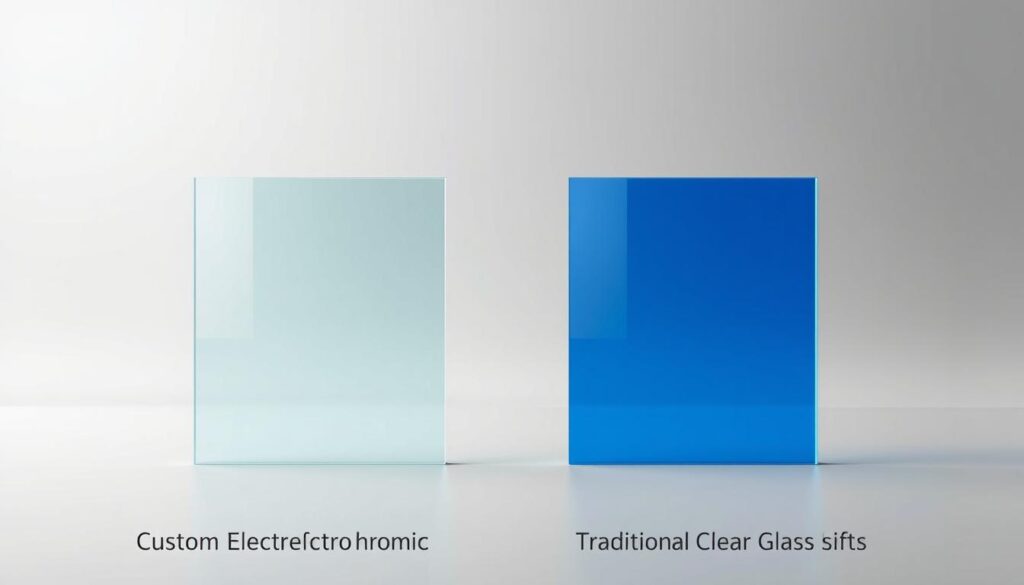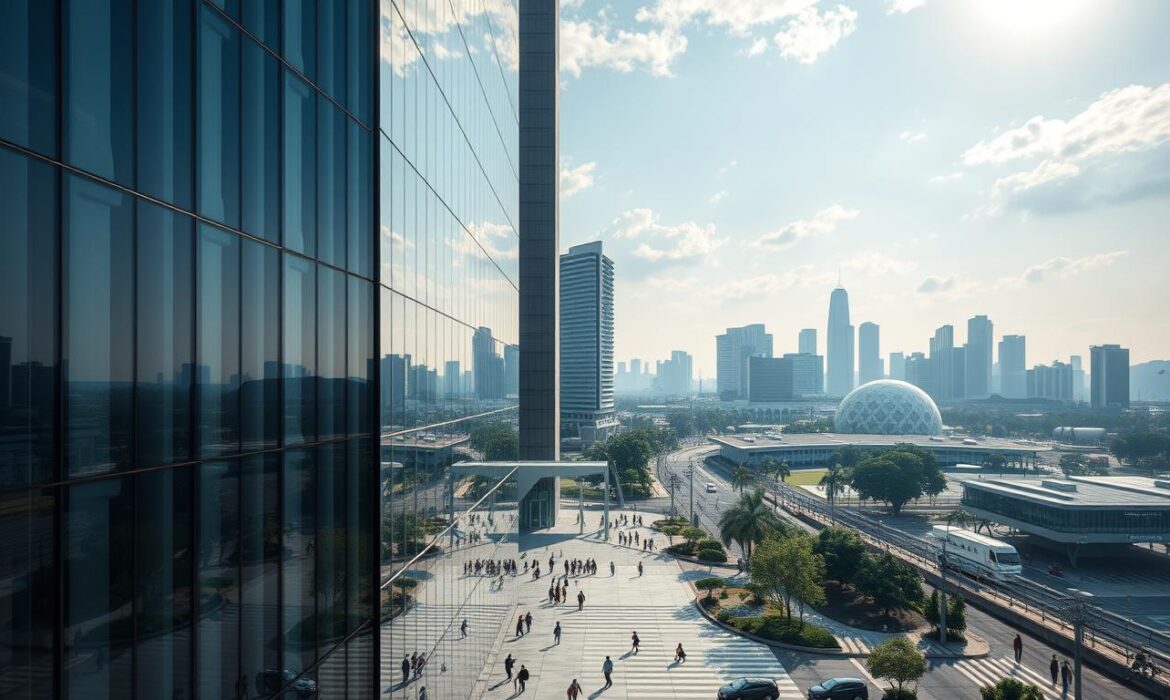Smart glass in Singapore is changing modern spaces with new tech. Electrochromic glass, like Nexus i-GLASS’s Nexus S-Guardlite and S-Powerlite, turns windows from clear to private with a touch. These solutions mix style with function, letting buildings adjust to light, temperature, and privacy needs easily.
Smart glass in Singapore, like Nexus S-Adlite and S-Shadelite, cuts energy costs by controlling heat and glare. They make buildings more sustainable without losing design, showing tech and beauty can go together. This innovation is changing how we build and use spaces.
Key Takeaways
- Electrochromic glass in Singapore uses smart technology to adjust transparency instantly.
- Nexus i-GLASS products like S-Guardlite improve energy efficiency and privacy.
- Smart glass solutions reduce reliance on traditional window treatments.
- These systems lower long-term energy costs while boosting building value.
- Custom options like S-Shadelite meet diverse design and functional needs.
Overview of Electrochromic Glass in Modern Architecture
Electrochromic innovations are changing how buildings are designed in Singapore. Architects focus on materials that look good and work well. This smart glass changes its opacity with electricity, making it popular in big projects.
Current Trends in Architectural Design
- Dynamic Light Control: Buildings like CapitaSpring use electrochromic windows to adjust sunlight in real time.
- Privacy on Demand: Offices in Marina Bay integrate glass that switches from transparent to opaque with a tap.
- Energy Efficiency: Eco-friendly buildings like Pinnacle@Duxton deploy this tech to reduce air conditioning needs.
Integration with Contemporary Structures
| Traditional Glass | Electrochromic Innovations |
|---|---|
| Fixed transparency levels | Adjustable tinting via smartphone apps |
| Requires manual window coverings | Automated light management systems |
| Higher cooling costs | Reduces energy consumption by 20-30% |
Architects in Singapore are using electrochromic glass in green buildings. This material helps designs adapt to the environment while looking modern. It’s key in 21st-century building design, from homes to offices.
The Science Behind Electrochromic Glass
Electrochromic glass is more than a design trend—it’s a scientific leap. It changes from clear to tinted thanks to precise engineering. This tech is key to energy-efficient glass systems, blending style with function.
How Electrochromic Technology Works
Electrochromic glass uses layers that react to electricity. Here’s how it works:
- A tungsten trioxide layer darkens when charged.
- Titanium dioxide stores ions for color changes.
- An applied voltage makes these changes happen fast.
Researchers at Singapore’s Nanyang Technological University (NTU) have improved this tech. They’ve made transitions smoother and longer-lasting.
Dynamic Light and Privacy Control Mechanisms
Unlike static glass, electrochromic systems adjust in real-time. Here’s a comparison:
| Function | Traditional Glass | Electrochromic |
|---|---|---|
| Light Control | Blinds or fixed tints | Instant light filtering via voltage |
| Privacy | Permanent partitions or curtains | Switch between transparent and private modes |
This tech blocks infrared rays but lets visible light through. It cuts down on air conditioning needs, leading in energy-efficient glass solutions.
Electrochromic Glass Singapore: Enhancing Energy Efficiency
Dynamic tinting glass is changing how Singapore builds sustainably. It adjusts its tint to control sunlight, cutting down on air conditioning use. This reduces heat gain, lowers energy needs, and supports green urban growth.

Sustainable Building Solutions
Dynamic tinting glass fits with Singapore’s green ambitions. NTU research found it blocks 70% of infrared radiation, reducing cooling needs by up to 30%. This cuts energy use and helps buildings get BCA Green Mark certifications.
The glass changes tint with sunlight, keeping buildings cool without overusing HVAC systems.
- Reduces indoor heat buildup by adjusting tint levels
- Meets strict energy efficiency requirements
- Supports Singapore’s 2030 Green Plan targets
Cost Savings and Environmental Impact
Switching to dynamic tinting glass saves money in the long run. It lowers energy bills, making up for the initial cost. Buildings using it also cut carbon emissions, helping Singapore meet climate goals.
Dynamic tinting glass offers benefits for both businesses and the environment. It’s a crucial step toward greener buildings in Singapore’s climate.
Customization and Design Flexibility
Electrochromic glass changes the game for modern architecture glass design. Architects in Singapore can turn regular glass into something special. They can make glass panels change how much light they let in, their color, and more.
- Dynamic Tinting: Switch from transparent to opaque with a touch, creating privacy or sunlight control.
- Advertising Displays: Integrate digital visuals into glass surfaces for eye-catching storefronts or corporate branding.
- Patterned Designs: Embed geometric or abstract motifs while retaining functional smart glass capabilities.
Products like Nexus S-Adlite show how flexible this glass can be. These panels can be added to buildings that already exist. This makes it easy to upgrade without changing the look of the building.
Designers use these panels to create unique spaces. Imagine office walls that can show digital content or lobby windows that change with the day. This makes spaces feel new and tailored to each user.
In Singapore, architects can make every project unique. Modern architecture glass is not just a material; it’s a blank canvas. Whether it’s a simple apartment or a high-tech office, this glass makes it all possible.
Installation and Maintenance Insights
For privacy control glass systems like electrochromic ones, smooth operation is key. This requires careful installation and regular care. Professionals use special techniques to make sure they last and work well.
Professional Installation Techniques
- Clean surfaces must be free of dust and debris before applying the film.
- Test the system’s connectivity with transformers and remotes before final assembly.
- Use distilled water and squeegees to eliminate air bubbles during application.
Maintenance Best Practices
Keeping electrochromic systems in good shape is important. Here are some tips:
- Clean panes monthly with soft cloths and mild soap—avoid ammonia or abrasive tools.
- Inspect edges quarterly for bubbles or cracks and address issues immediately.
- Reduce humidity indoors to 30-50% to prevent condensation between layers.
Places like Tokyo’s Kudan Kaikan Terrace and Los Angeles’ Regatta Seaside show the benefits of careful installation and upkeep. For example, INOVUES’ work at Regatta Seaside turned old windows into energy-saving privacy control glass without changing the building. They also check the systems every eight years to keep them working at their best.
Comparing Electrochromic and Traditional Glass Solutions

Electrochromic glass and traditional glass have different effects on light, energy, and style. Here’s a detailed comparison:
| Feature | Electrochromic Glass | Traditional Glass |
|---|---|---|
| Energy Efficiency | Reduces heat by 40% (NTU studies) | Fixed transparency |
| Customization | Adapts with custom glass design options | Limited to tinting or coatings |
| Switching Speed | Adjusts in seconds via electric signals | No real-time adjustments |
| Maintenance | Low-cost upkeep | Regular cleaning required |
In Singapore, commercial buildings often pick custom glass design for style and function. Electrochromic panels offer quick light control without blinds or shades. For example, Jewel Changi Airport uses smart glass to manage glare and keep views open.
- Electrochromic glass cuts cooling costs by adapting to sunlight
- Traditional glass requires manual adjustments like curtains or shutters
Architects in Singapore now favor switchable glass for custom glass design projects. This technology adjusts to weather and user needs, unlike fixed panes. The outcome? Spaces that are comfortable and modern-looking.
Innovative Applications Across Industries
Electrochromic glass is more than a tech trend. It’s a big change for places where looks and function meet. It’s used in homes and hospitals, making installation smart glass a simple way to upgrade.
“The flexibility of smart glass allows spaces to evolve with user needs, not just time zones.” — Architect Lim Wei Ting, Green Horizon Designs
Residential Applications
In Singapore, homeowners are using installation smart glass to change their living areas. In places like Marina Bay Residences, they can turn sunlit terraces into private rooms with just a tap. Luxury homes like Tanjong Katong Villas use it to control light and keep things private, without needing big curtains.
Commercial & Institutional Uses
Offices and hospitals are leading in using this tech on a big scale. Here are some examples:
| Industry | Application | Benefit |
|---|---|---|
| Commercial | Conference rooms with dimmable windows | Reduces artificial lighting costs by up to 30% |
| Retail | Interactive storefront displays | Dynamic visuals attract 40% more foot traffic (2023 Retail Tech Report) |
| Healthcare | ICU room partitions | Adjusts light exposure for patient recovery cycles |
In places like Khoo Teck Puat Hospital, smart glass lets nurses watch over patients without losing privacy. Retail stores like Isetan use it to change their window ads based on when people shop most. These examples show installation smart glass is more than a material—it’s a way to design.
Future Trends in Smart Glass Technology
Smart glass technology is getting better, offering more benefits for buildings in Singapore and worldwide. Researchers at National University of Singapore are making big strides in materials science. They’re working on windows that change color in seconds or clean themselves with UV light.
“Next-gen electrochromic films could cut energy use by 40% while slashing maintenance costs,” says Dr. Lim Wei Liang, a materials scientist leading NTU’s smart materials lab.
Next-Generation Innovations
- Perovskite coatings: New light-sensitive layers enable faster tint transitions
- Graphene-infused substrates: Boost durability for tropical climates
- AI integration: Automated systems learning user preferences for optimal comfort
Market Growth Projections
Experts predict the retrofit switchable glass market will expand by 12% CAGR by 2030. The main reasons are:
- Government sustainability mandates
- Retrofit demand from commercial buildings
- Residential adoption for smart homes
These advancements make retrofit switchable glass key to Singapore’s Smart Nation goals. It’s changing both new and old buildings.
Understanding Costs and Investment Return
When we talk about smart window applications, the cost is a big concern. But, studies show that the long-term savings are worth it. A 2023 study by Nanyang Technological University (NTU) found that buildings with electrochromic glass save up to 25% on energy bills every year.
“Smart glass systems pay for themselves in 5–7 years through reduced cooling and lighting costs.”
Several factors affect the return on investment:
- Energy rebates from Singapore’s Green Building Masterplan
- Lower HVAC maintenance needs
- Increased property value (up to 4-6% per sqm, per URA 2024 reports)
While installing smart windows might cost 15-30% more than regular glass, they save money in the long run. Places like Singapore’s Jewel Changi or CapitaSpring pay off faster because of their high foot traffic and energy use.
Investors can see a 12-18% annual return from tenants who want green spaces. These systems also help with solar gain and glare, making them a smart choice for Singapore’s 2030 Green Plan.
Conclusion
Electrochromic glass is changing the game for sustainable building glass in Singapore. It adjusts its transparency to save energy, cutting it by 5–15%. This also lowers cooling needs by up to 25%, helping meet Singapore’s 2030 green building goals.
Studies at BCA SkyLab show Halio’s EC glazing cuts glare and saves 17–25% in lighting energy. This shows how smart glass improves comfort, efficiency, and looks without losing views.
Singapore’s hot and humid weather makes electrochromic glass even more useful. It controls heat and light, making spaces more comfortable and reducing AC use. This supports Singapore’s goal to cut emissions and carbon footprints while keeping designs flexible.
For architects and developers, choosing electrochromic glass is a smart move. It’s more than just windows; it’s about buildings that adapt to their surroundings. See how this tech can meet your project’s needs and set new standards for architecture in Singapore.

